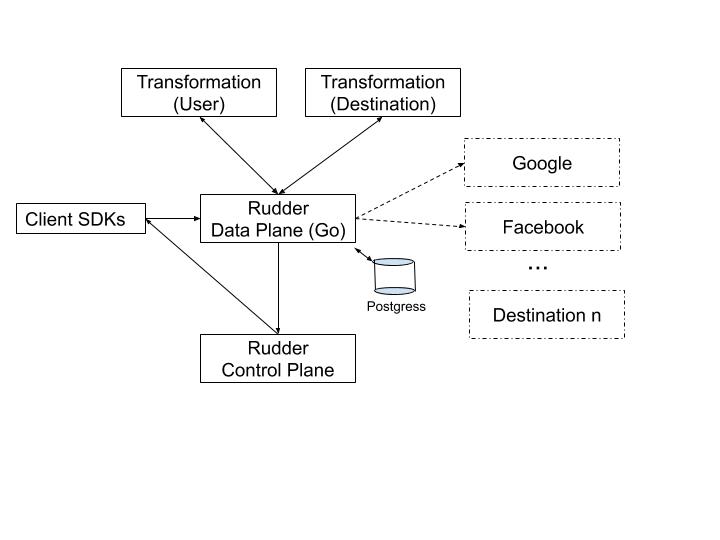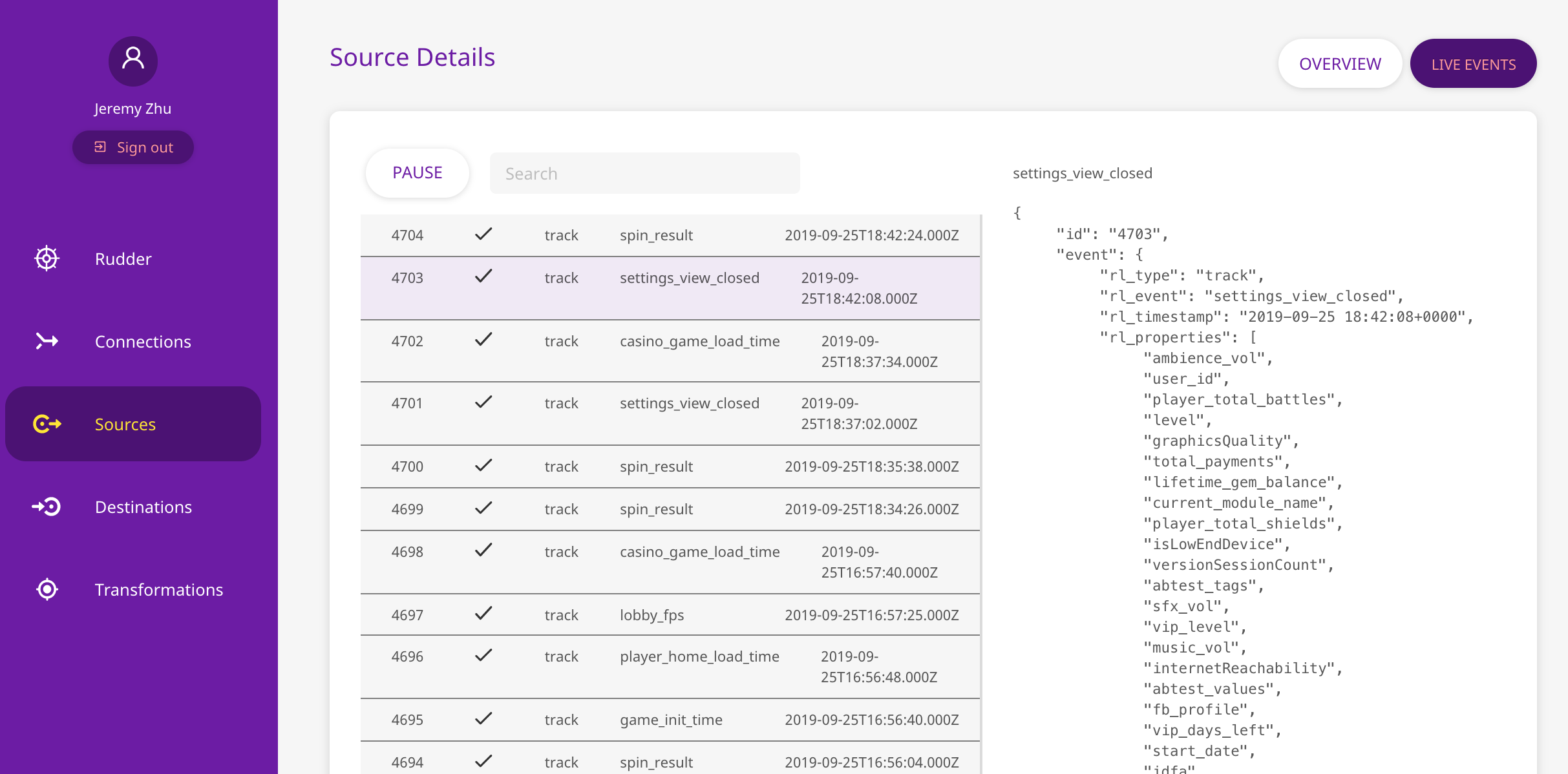Short answer: Rudder is an open-source Segment alternative written in Go, built for the enterprise. .
Long answer: Rudder is a platform for collecting, storing and routing customer event data to dozens of tools. Rudder is open-source, can run in your cloud environment (AWS, GCP, Azure or even your data-centre) and provides a powerful transformation framework to process your event data on the fly.
Rudder runs as a single go binary with Postgres. It also needs the destination (e.g. GA, Amplitude) specific transformation code which are node scripts. This repo contains the core backend and the transformation modules of Rudder. The client SDKs are in a separate rep Rudder Client SDKs. We will open source the UI code soon.
Rudder server is released under SSPL License
Please register here https://app.rudderlabs.com and follow the instructions below to setup Rudder.
Questions? Join our Discord or Slack channel. Or please email soumyadeb at rudderlabs.com.
We are building Rudder because we believe open-source and cloud-prem is important for three main reasons
-
Privacy & Security: You should be able to collect and store your customer data without sending everything to a 3rd party vendor or embedding proprietary SDKs. With Rudder, the event data is always in your control. Besides, Rudder gives you fine-grained control over what data to forward to what analytical tool.
-
Processing Flexibility: You should be able to enhance OR transform your event data by combining it with your other internal data, e.g. stored in your transactional systems. Rudder makes that possible because it provides a powerful JS-based event transformation framework. Furthermore, since Rudder runs inside your cloud or on-prem environment, you can access your production data to join with the event data.
-
Unlimited Events: Event volume-based pricing of most commercial systems is broken. You should be able to collect as much data as possible without worrying about overrunning event budgets. Rudder's core BE is open-source and free to use.
- Google Analytics, Amplitude, MixPanel & Facebook destinations. Lot more coming soon.
- S3 dump. Redshift and other data warehouses coming soon.
- User-specified transformation to filter/transform events.
- Stand-alone system. The only dependency is on Postgres.
- High performance. On a single m4.2xlarge, Rudder can process ~3K events/sec. Performance numbers on other instance types soon.
- Rich UI written in react.
- Android, iOS, Unity & Javascript SDKs. Server-side SDKs coming soon.
Join our Discord or Slack channel
The docker setup is the easiest & fastest way to try out Rudder.
- Go to the dashboard
https://app.rudderlabs.comand set up your account. Copy your workspace token from top of the home page. - Clone this repository and replace
<your_workspace_token>inbuild/docker.envwith the above token. - Run
git submodule initandgit submodule updateto fetch the rudder-transformer repo. - Run the command
docker-compose upto bring up all the services. - If you already have a Google Analytics account, keep the tracking ID handy. If not, please create one and get the tracking ID.
- Create one source (Android or iOS) and configure a Google Analytics destination for the same with the above tracking ID
- We have bundled a shell script that can generate test events. Get the source “writeKey” from our app dashboard and then run the following command. Run
./scripts/generate-event <writeKeyHere> - You can then login to your Google Analytics account and verify that events are delivered in the correct order.
- You can use our Android, iOS or Javascript SDKs for sending events from your app.
- If you want to try a demo version, check out
https://github.com/rudderlabs/rudder-docker
If you want to run each of the services without docker please follow the following steps
- Install Golang 1.12 or above. Download Here
- Install NodeJS 10.6 or above. Download Here
- Install PostgreSQL 10 or above and set up the DB
createdb jobsdb
createuser --superuser rudder
psql "jobsdb" -c "alter user rudder with encrypted password 'rudder'";
psql "jobsdb" -c "grant all privileges on database jobsdb to rudder";
- Go to the dashboard and set up your account. Copy your workspace token from top of the home page
- Clone this repository. Run
git submodule initandgit submodule updateto fetch the rudder-transformer repo. and navigate to the transformer directorycd rudder-transformer - Start the user and destination transformers as separate processes
node userTransformer.jsandnode destTransformer.js - Navigate back to main directory
cd rudder-server. Copy the sample.env to the main directorycp config/sample.env .env - Update the
CONFIG_BACKEND_TOKENenvironment variable with the token fetched in step 4 - Run the backend server
go run -mod=vendor main.go - Setup your sources from the dashboard
https://app.rudderlabs.comand start sending events using the test script (mentioned in step 5 of Docker setup instructions) or our SDKs.
The following is a brief overview of the major components of Rudder Stack.

The UI to configure the sources, destinations etc. It consists of
Config backend: This is the backend service that handles the sources, destinations and their connections. User management and access based roles are defined here.
Customer webapp: This is the front end application that enables the teams to set up their customer data routing with Rudder. These will show you high-level data on event deliveries and more stats. It also provides access to custom enterprise features.
Data plane is our core engine that receives the events, stores, transforms them and reliably delivers to the destinations. This engine can be customized to your business requirements by a wide variety of configuration options. Eg. You can choose to enable backing up events to an S3 bucket, the maximum size of the event for the server to reject malicious requests. Sticking to defaults will work well for most of the companies but you have the flexibility to customize the data plane.
The data plane uses Postgres as the store for events. We built our streaming framework on top of Postgres – that’s a topic for a future blog post. Reliable delivery and order of the events are the first principles in our design.
Conversion of events from Rudder format into destination-specific format is handled by the transformation module. The transformation codes are written in Javascript. I
The following blogs provide an overview of our transformation module
https://rudderlabs.com/transformations-in-rudder-part-1/
https://rudderlabs.com/transformations-in-rudder-part-2/
If you are missing a transformation, please feel free to add it to the repository.
Rudder also supports user-specific transformations for real-time operations like aggregation, sampling, modifying events etc. The following blog describes one real-life use case of the transformation module
https://rudderlabs.com/customer-case-study-casino-game/
The client SDKs provide APIs collecting events and sending it to the Rudder Backend.
- More performance benchmarks. On a single m4.2xlarge, Rudder can process ~3K events/sec. We will evaluate other instance types and publish numbers soon.
- More documentation
- More destination support
- HA support
- More SDKs (or Segment compatibility)
- Transformations from UI




